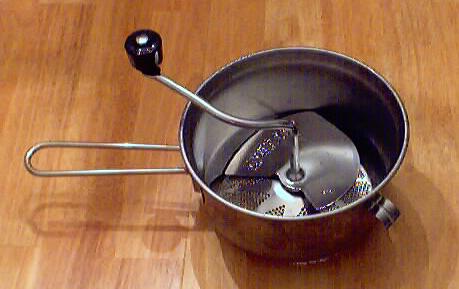
Looking for How to Make Pear Jam or Pear Jelly - Easily! With Step-by-step Photos, Recipe, Directions, Ingredients and Costs in 2025? Scroll down this page and follow the links. And if you bring home some fruit or vegetables and want to can, freeze, make jam, salsa or pickles, see this page for simple, reliable, illustrated canning, freezing or preserving directions. There are plenty of other related resources, click on the resources dropdown above. If you are having a hard time finding canning lids, I've used these, and they're a great price & ship in 2 days.
If you have questions or feedback, please let me know! There are affiliate links on this page. Read our disclosure policy to learn more.
How to Make Pear Jam or Pear Jelly - Easily! With Step-by-step Photos, Recipe, Directions, Ingredients and Costs
How to Make Homemade Pear Jam or Jelly
 Making
and canning your own pear jam, pear preserves or pear jelly is quite easy.
Here's how to do it, in 13 easy steps and completely illustrated.
Essentially, pears cook much like apples; they simply tend to be more
grainy. So almost anything you can make with apples, you can make with
pears.
Making
and canning your own pear jam, pear preserves or pear jelly is quite easy.
Here's how to do it, in 13 easy steps and completely illustrated.
Essentially, pears cook much like apples; they simply tend to be more
grainy. So almost anything you can make with apples, you can make with
pears.Also, see our easy illustrated directions about how to can pears, pear picking tips, make pear or applesauce, pear or apple butter and our list of apple festivals!
Ingredients and Equipment
Yields about 8 or 9 jars, each 8 oz
|
|
Recipe and Directions
Step 1 - Selecting the pears
 The
most important step! You need pears that are sweet if you want to
cut down on the added sugar.
The
most important step! You need pears that are sweet if you want to
cut down on the added sugar.
Step 2 - How many pears and where to get them
You can pick your own, or buy them at the grocery store. But for large quantities, you will find that real farmer's markets, like the State Farmer's Market in Forest Park, Georgia have them at the best prices. In 2007, they were available from late September at $12 to $20 per bushel.
You will get about 14 quarts of pear jelly per bushel of
pears.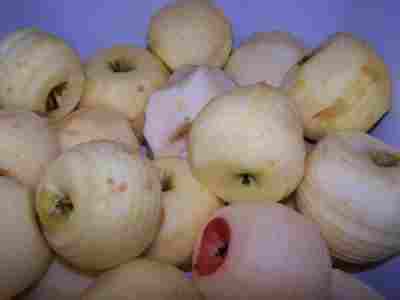
Step 3 -Wash and peel the pears!
I'm sure you can figure out how to wash the pears in plain cold water and remove any stickers or labels on them.
Using a vegetable peeler or a paring knife, peel the pears.
Step 4 -Chop the pears!
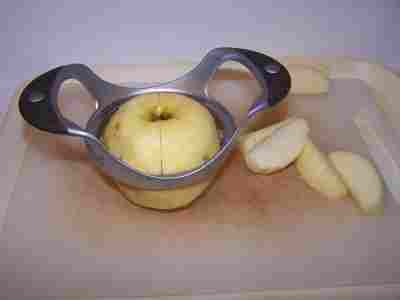 Chopping
them is much faster if you use one of those pear corer/segmenters - you
just push it down on an pear and it cuts it into segments.
Chopping
them is much faster if you use one of those pear corer/segmenters - you
just push it down on an pear and it cuts it into segments. 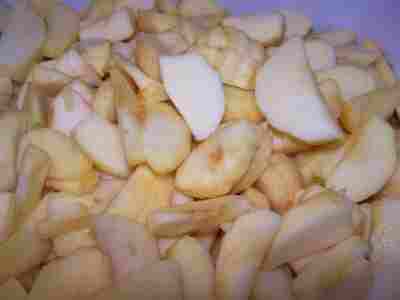
Using a paring knife, be sure to remove any seeds, hard parts (usually the part around the seeds) and any mush or dark areas.
Step 5 - Cook the Pears
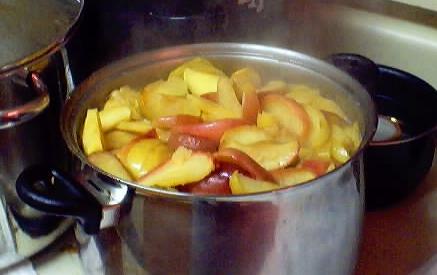 Pretty
simple! Put about 1 inch of water (I used either filtered tap water or
store brand pear juice) on the bottom of a huge, thick-bottomed pot. Put
the lid on, and the heat on high. When it gets really going, turn
it to medium high until the pears are soft through and through.
Pretty
simple! Put about 1 inch of water (I used either filtered tap water or
store brand pear juice) on the bottom of a huge, thick-bottomed pot. Put
the lid on, and the heat on high. When it gets really going, turn
it to medium high until the pears are soft through and through.
Yes, this picture shows skins (I didn't have a photo of this step with peeled pears) and you CAN leave the skins on; it just clogs up the strainer more and takes more time. On the plus side, leaving on the skins usually imparts a little more flavor, plus the color of the skins to the finished jelly!
Step 6 - Decide whether you want to make pear jam or pear jelly
If you want pear jelly, you will need to filter, sieve or strain the pears - see step 6a.
If you want top make pear jam, you can just use a food mill, which is faster and easier. See step 6b.
Step 6a - Jellies: Filter or sieve the cooked pears
|
 See here for jelly strainers and jam and jelly-making supplies on Amazon
See here for jelly strainers and jam and jelly-making supplies on Amazon |
Step 6b - Jams: Simply crush or strain the cooked pears
Depending upon how chunky you like your jam, you can just vigorously stir the cooked pears or strain them for a smoother consistency.
A simple and fairly inexpensive ($20 - $30) food mill, like the Foley food mill is the easiest, fastest way to strain or sieve the cooked pears and also to separate any remaining skins, seeds, hard parts of the core and stems from the pear sauce. Without a food mill, you will have to use a colander which is hard and slow work!
In fact, with a food mill or strainer, if you are making jam, you can just chop the whole pears and cook them down, then run it through the food mill or strainer. Click on the links below or see the bottom of this page for more information and to order! The VillaWare model can handle higher volumes than a Foley food mill (without giving you cramps!)
See here for related tools, equipment, supplies on Amazon
See here for related tools, equipment, supplies on Amazon To see a greater variety of strainers in other types, sizes, and prices, click here!
Step 7 - Measure out the sweetener
Depending upon which type of jam or jelly you're making (sugar, no-sugar, Stevia (but you will have to experiment with amount, each brand of Stevia is a different concentration), or Splenda, or a mix of sugar and Stevia (or Splenda) or fruit juice) you will need to use a different amount of sugar and type of pectin. The precise measurements are found in directions inside each and every box of pectin sold (every brand, Ball, Kerr, Mrs. Wages, etc. has directions inside). I haven't seen a jelly recipe that uses only Stevia (in a prepared form like Truvia, it measures same as sugar; if you use another form, you will need do your own conversion) - or Splenda, if you prefer, , and I haven't yet tried it; I suspect it would taste bland.
| Type of jam |
Type of pectin to buy |
Sweetener |
| regular | regular | 7 cups of sugar |
| lower sugar | lower-sugar | 4.5 cups of sugar |
| lowest sugar | no-sugar | 4 cups Splenda (or about 1/3 that if you use Stevia, which is my preference) |
| lower sugar | lower-sugar or no-sugar | 2 cups sugar and 2 cups Splenda (or about 1/3 that if you use Stevia, which is my preference) |
| no sugar | no-sugar | 4 cups Splenda (or about 1/3 that if you use Stevia, which is my preference) |
| natural | no-sugar | 3 cups fruit juice (grape, pear, apple or mixed) |
Step 8 - Mix the dry pectin with about 1/4 cup of sugar or other sweetener
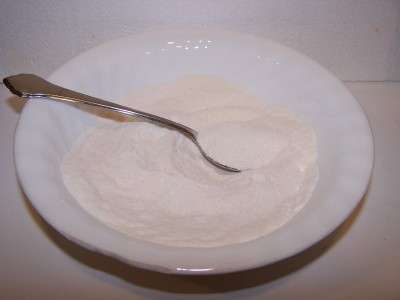 In
a small bowl, mix the dry pectin with about 1/4 cup of sugar (or other
sweetener). Keep this separate from the rest of the sugar. If you are not
using sugar, you will just have to stir more vigorously to prevent the pectin
from clumping.
In
a small bowl, mix the dry pectin with about 1/4 cup of sugar (or other
sweetener). Keep this separate from the rest of the sugar. If you are not
using sugar, you will just have to stir more vigorously to prevent the pectin
from clumping.
Notes about pectin: I usually add about 25% - 30% more pectin (just open another pack and add a little) or else the jam is runnier than I like. With a little practice, you will find out exactly how much pectin to get the thickness you like.
For more about the types of pectin sold,
see this page!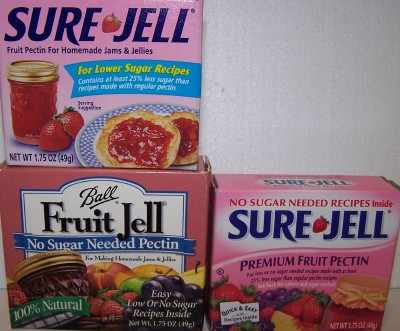

Is your jam too runny? Pectin enables you to turn out perfectly set jam
every time. Made from natural pears, there are also natural no-sugar pectins
that allow you to reduce the sugar you add by half or even eliminate sugar.!
Get canning jars, rings, lids and pectin deliverd:
Step 9 - Mix the pear juice with the pectin and cook to a full boil
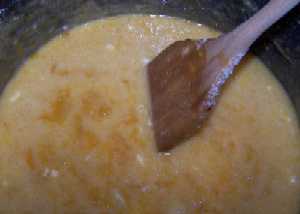 Stir
the pectin into the pear juice and put the mix in a big pot on the stove
over medium to high heat (stir often enough to prevent burning). It
should take about 5 to 10 minutes to get it to a full boil (the kind
that cannot be stirred away).
Stir
the pectin into the pear juice and put the mix in a big pot on the stove
over medium to high heat (stir often enough to prevent burning). It
should take about 5 to 10 minutes to get it to a full boil (the kind
that cannot be stirred away).
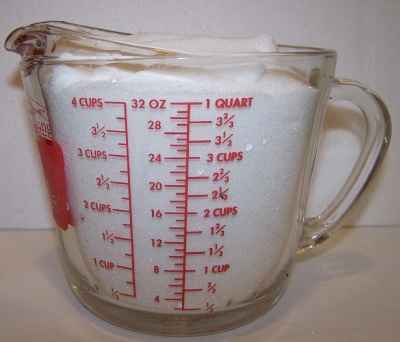
Step 10 - Add the remaining sugar and bring to a boil
When the pear-pectin mix has reached a full boil, add the rest of the sugar (or other sweetener) and then bring it back to a boil and boil hard for 1 minute.
Step 10 - Testing for "jell" (thickness)
I
keep a metal tablespoon sitting in a glass of ice water, then take a half
spoonful of the mix and let it cool to room temperature on the spoon. If
it thickens up to the consistency I like, then I know the jam is ready. If
not, I mix in a little more pectin (about 1/4 to 1/2 of another package)
and bring it to a boil again for 1 minute.
Step 11 - Fill the jars and put the lid and rings on
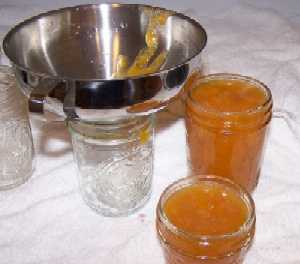 Fill
them to within 1/4-inch of the top, wipe any spilled jam off the top, seat
the lid and tighten the ring around them. Then put the filled jars into the canner!
Fill
them to within 1/4-inch of the top, wipe any spilled jam off the top, seat
the lid and tighten the ring around them. Then put the filled jars into the canner!
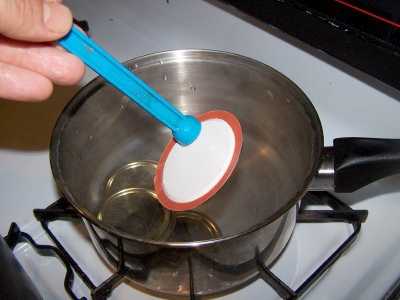 This
is where the jar tongs and lid lifter come in really handy!
This
is where the jar tongs and lid lifter come in really handy!
Step 12 - Process the jars in the boiling water bath
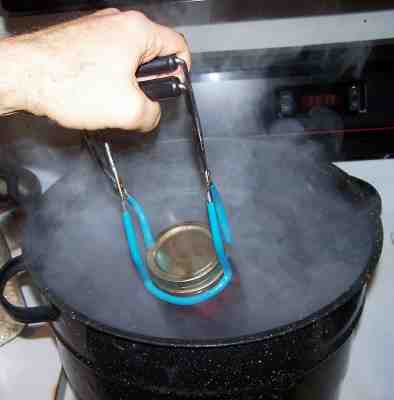 Keep
the jars covered with at least 2 inches of water. Keep the water boiling. In
general, boil them for 10 minutes, which is what SureJell (the makers of the
pectin) recommend. I say "in general" because you have to process
(boil) them longer at higher altitudes than sea level, or if you use larger
jars,
Keep
the jars covered with at least 2 inches of water. Keep the water boiling. In
general, boil them for 10 minutes, which is what SureJell (the makers of the
pectin) recommend. I say "in general" because you have to process
(boil) them longer at higher altitudes than sea level, or if you use larger
jars,
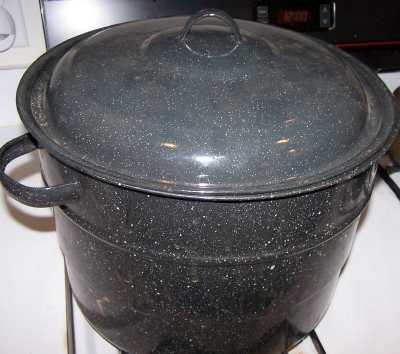 or
if you did not sanitize the jars and lids right before using them. The
directions inside every box of pectin will tell you exactly. The
directions on the pectin tend to be pretty conservative. Clemson
University says you only need to process them for 5 minutes. I usually
hedge my bets and start pulling them out after 7 minutes, and the last jars
were probably in for 10. I rarely have a jar spoil, so it must work.
or
if you did not sanitize the jars and lids right before using them. The
directions inside every box of pectin will tell you exactly. The
directions on the pectin tend to be pretty conservative. Clemson
University says you only need to process them for 5 minutes. I usually
hedge my bets and start pulling them out after 7 minutes, and the last jars
were probably in for 10. I rarely have a jar spoil, so it must work.
Note: Some people don't even boil the jars; they just ladle it hot into hot jars, put the lids and rings on and invert them, (this is called "open kettle" processing). Open kettle process is universally condemned by all of the authorities (USDA, FDA, Universities - Clemson, UGa, Minnesota, WI, Michigan, etc,.) as being inherently dangerous and conducive to botulism. It does not create a sterile environment; it does create the ideal environment for botulism to grow.
Putting the jars in the boiling water bath REALLY helps to reduce spoilage! To me, it makes little sense to put all the working into making the jam and then not to process the jars to be sure they don't spoil or risk your family's health.!
Step 13 - Remove and cool the jars - Done!
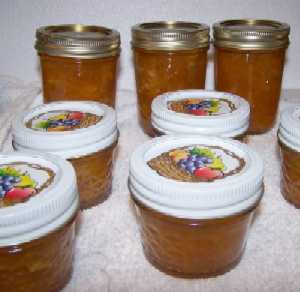 Lift
the jars out of the water and let them cool without touching or bumping
them in a draft-free place (usually takes overnight) You can then remove
the rings if you like, but if you leave them on, at least loosen them
quite a bit, so they don't rust in place due to trapped moisture. Once
the jars are cool, you can check that they are sealed verifying that the
lid has been sucked down. Just press in the center, gently, with your
finger. If it pops up and down (often making a popping sound), it is not
sealed. If you put the jar in the refrigerator right away, you can still
use it. Some people replace the lid and reprocess the jar, then that's a
bit iffy. If you heat the contents back up, re-jar them (with a new lid)
and the full time in the canner, it's usually ok.
Lift
the jars out of the water and let them cool without touching or bumping
them in a draft-free place (usually takes overnight) You can then remove
the rings if you like, but if you leave them on, at least loosen them
quite a bit, so they don't rust in place due to trapped moisture. Once
the jars are cool, you can check that they are sealed verifying that the
lid has been sucked down. Just press in the center, gently, with your
finger. If it pops up and down (often making a popping sound), it is not
sealed. If you put the jar in the refrigerator right away, you can still
use it. Some people replace the lid and reprocess the jar, then that's a
bit iffy. If you heat the contents back up, re-jar them (with a new lid)
and the full time in the canner, it's usually ok.
Once cooled, they're ready to store. I find they last up to 12 months. But after about 6 to 8 months, they get darker in color and start to get runny. They still are safe to eat, but the flavor and texture aren't as good. So eat them in the first 6 months after you prepare them!
Other Equipment:
From left to right:
- Jar lifting tongs
helpful to pick up hot jars
- Lid lifter
- to remove lids from the pot
of hot water - Lids
- disposable - you may only
use them once - Ring
- holds the lids on the jar until after
the jars cool - then you remove them, save them and reuse them - Canning Jar funnel
- to fill the jars
Looking for canning equipment and supplies?
Water bath canner with a jar rack
Pressure canners for gas, electric and induction stoves: Presto 23Qt or T-fal 22Qt
Canning scoop (this one is PERFECT)
Ball Blue book (most recent version)
Jars: 8oz canning jars for jams
Find Other types of farms:
Farm markets and roadside stands
Road trips and camping resources
Local Honey, apiaries, beekeepers
Consumer fraud and scams information
Home canning supplies at the best prices on the internet!
Maple Syrup Farms, sugarworks, maple syrup festivals
Environmental information and resources
Farms For Your Event for birthday parties, weddings, receptions, business meetings, retreats, etc.
Festivals - local fruit and vegetable festivals
Get the
most recent version of
the Ball Blue Book
With this Presto 23 quart pressure canner and pressure cooker, you can "can" everything, fruits, vegetables, jams, jellies, salsa, applesauce, pickles, even meats, soups, stews. Model 01781

You can make jams, jellies, can fruit, applesauce, salsa and pickles with water bath canners, like this Granite Ware 12-Piece Canner Kit, Jar Rack, Blancher, Colander and 5 piece Canning Tool Set

